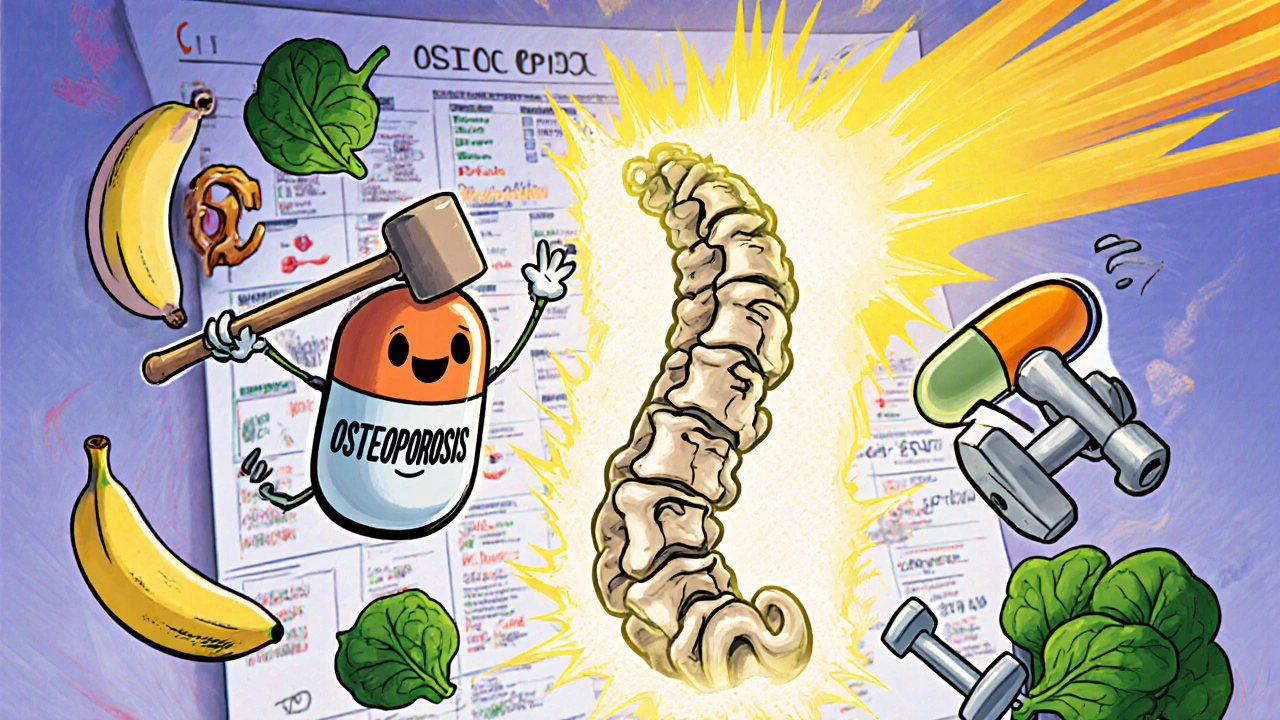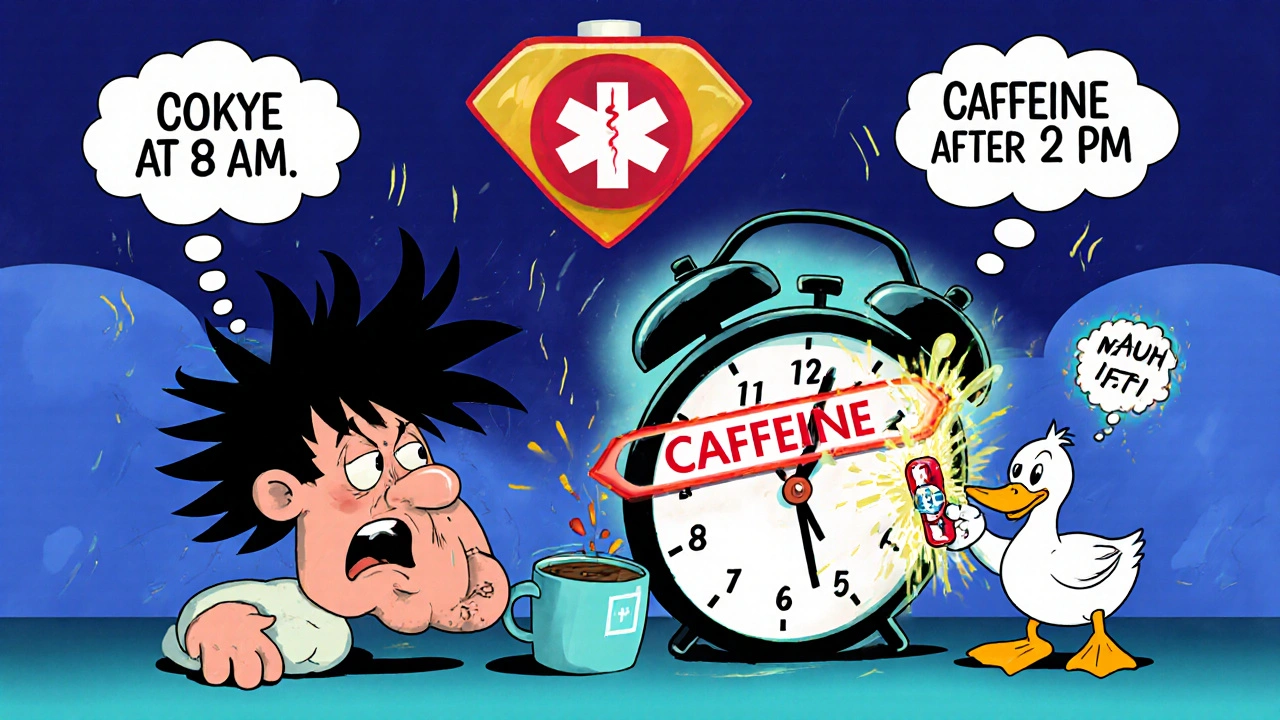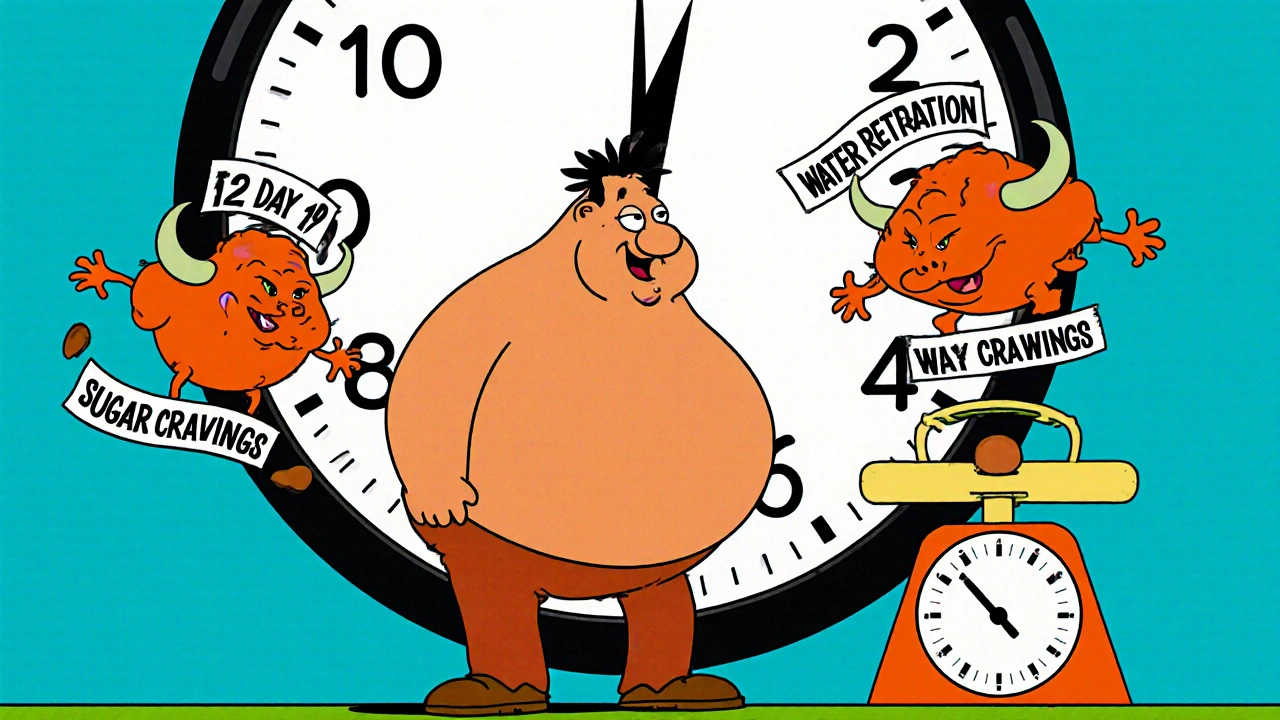Steroid Bone Loss Risk Calculator
Bone Density Risk Assessment
Calculate your risk of bone density loss based on steroid dosage and treatment duration.
Your Bone Density Risk Assessment
- Take 1,200 mg calcium daily (600 mg twice daily)
- Take 800-1,000 IU vitamin D daily
- Perform weight-bearing exercise 3x weekly
- Get DEXA scan at 6 months
When you’re on corticosteroids like prednisone or methylprednisolone, the relief can feel like magic. One day you’re struggling to walk, breathe, or even get out of bed. The next, your joints loosen, your lungs clear, and your body feels like it’s working again. But that relief doesn’t come free. For every hour of symptom control, your body pays a price - weight gain, mood swings, brittle bones, high blood sugar, and more. The truth? Corticosteroid side effects aren’t just annoying. They’re serious, common, and often preventable.
Why Corticosteroids Are a Double-Edged Sword
Corticosteroids work by shutting down inflammation fast. That’s why they’re used for flare-ups in rheumatoid arthritis, asthma attacks, lupus, and severe allergies. They can reduce swelling and pain within hours. But they don’t just target the bad inflammation. They hit your whole body like a sledgehammer. Your metabolism slows. Your immune system goes quiet. Your bones start to break down. Your muscles weaken. Your blood pressure climbs. And your mood? It can go from calm to furious in minutes. The numbers don’t lie. About 2% to 3% of adults are on these drugs long-term. And for those taking more than 7.5 mg of prednisone daily for over three months, the risk of serious side effects jumps dramatically. One in two people gain weight. One in three develop high blood pressure. One in four start showing signs of insulin resistance. And nearly half of long-term users lose bone density - fast.Weight Gain: It’s Not Just About Eating Too Much
If you’ve been on steroids for more than a few weeks and noticed your face rounding out, your belly swelling, or your clothes getting tight, you’re not lazy. You’re not failing at dieting. You’re experiencing a real biological shift. Corticosteroids change how your body stores fat. They push fat to your face, neck, and abdomen - the classic "moon face" and "buffalo hump." They also make you hungrier, especially for carbs and sugar. And they cause your body to hold onto water, adding another 5 to 10 pounds of fluid weight. This isn’t just cosmetic. Extra belly fat raises your risk of heart disease and type 2 diabetes. The fix? Start with sodium. Cut salt to under 1,500 mg a day. That means skipping processed foods, canned soups, and restaurant meals. Eat more potassium-rich foods like bananas, spinach, sweet potatoes, and beans - they help flush out excess fluid. Protein is your friend too. It keeps you full longer and helps preserve muscle mass as your body breaks down tissue.Bone Loss: The Silent Threat
You won’t feel your bones getting weaker. There’s no pain. No warning. Just a DEXA scan months later showing osteopenia - or worse, osteoporosis. Steroids directly interfere with bone-building cells. They also reduce calcium absorption and increase calcium loss through urine. After just three months on steroids, bone loss can begin. After two years? Up to 50% of users have measurable bone density loss. The fix is simple, but it must start on day one. Take 1,200 mg of calcium daily - split into two doses (600 mg each) for better absorption. Pair it with 800-1,000 IU of vitamin D. If you’re over 65 or have a history of fractures, your doctor may add a bisphosphonate like alendronate. Weight-bearing exercise matters too. Walk 30 minutes a day. Lift light weights. Even standing on one foot for a minute helps improve balance and reduces fall risk.
High Blood Sugar and Diabetes Risk
Corticosteroids make your liver pump out more glucose. They also make your muscles and fat cells less sensitive to insulin. The result? Blood sugar spikes - even in people who’ve never had diabetes before. About 10% to 20% of long-term steroid users develop type 2 diabetes. Another 25% to 30% show signs of insulin resistance. The key is catching it early. Get a fasting blood sugar test when you start steroids. Then every three months. If your fasting level is above 100 mg/dL, you’re in prediabetes territory. Your doctor may recommend metformin - a safe, low-cost drug that helps your body use insulin better. Avoid sugary drinks, white bread, and pastries. Choose whole grains, vegetables, lean proteins, and healthy fats. Monitor your blood sugar at home if you’re at high risk.Mood Swings, Insomnia, and Mental Health
"I cried over spilled coffee. I yelled at my kids for no reason. I felt like I was losing my mind." That’s a real quote from someone on Reddit. Steroids affect the brain. They can trigger anxiety, depression, irritability, and even psychosis in rare cases. Insomnia is almost universal - especially if you take your dose after noon. The fix? Timing matters. Take your steroid in the morning, right after breakfast. That mimics your body’s natural cortisol rhythm and reduces sleep disruption. Avoid caffeine after 2 p.m. Practice good sleep hygiene: no screens an hour before bed, keep your room cool and dark. If anxiety or mood changes hit hard, talk to your doctor. You may need short-term support with an antidepressant or anti-anxiety medication - not because you’re weak, but because the drug is changing your brain chemistry.
How to Safely Get Off Steroids
You can’t just stop. Ever. Suddenly stopping corticosteroids after more than a few weeks can trigger adrenal crisis - a life-threatening drop in cortisol. Your body forgets how to make its own. Tapering is non-negotiable. If you were on 20 mg or more daily, drop by 2.5-5 mg every 3-7 days. Once you’re under 10 mg, slow down: drop 1 mg every 1-2 weeks. Below 5 mg? Drop 0.5 mg every week or two. Your doctor should monitor you for fatigue, dizziness, nausea, or low blood pressure - signs your adrenal glands aren’t catching up. And here’s the kicker: even after you stop, your body may need stress-dose steroids for up to a year if you get sick, have surgery, or suffer a major injury. Always carry a medical alert card or bracelet that says you’ve been on steroids.What Works Better Than Just Waiting
Some doctors treat the symptoms without addressing the cause. But the best approach is layered:- Calcium + Vitamin D: Start on day one if you’re on ≥5 mg prednisone daily for more than 3 months.
- Sodium restriction: Under 1,500 mg/day cuts fluid retention and blood pressure spikes.
- Regular blood sugar checks: Fasting glucose every 3 months, HbA1c every 6 months.
- Bone density scans: DEXA scan at 6 months, then annually if you’re on long-term therapy.
- Exercise: Weight-bearing and resistance training 3x/week protects bones and muscles.
- Psychological support: Don’t ignore mood changes. Therapy or medication can help.
The Future: Safer Steroids on the Horizon
Scientists aren’t giving up on corticosteroids - they’re trying to make them smarter. New drugs called SEGRMs (selective glucocorticoid receptor modulators) are in trials. One, vamorolone, works just as well as prednisone for muscle inflammation but causes 40% less bone loss. Another approach targets enzymes in the liver that turn steroids into their harmful forms - blocking those enzymes could reduce diabetes risk without losing anti-inflammatory power. In five years, genetic testing might tell you if you’re prone to steroid-induced weight gain or bone loss. That way, your dose can be personalized - not one-size-fits-all. But until then? The best defense is awareness, planning, and proactive care. You don’t have to choose between relief and ruin. With the right supportive therapies, you can use steroids safely - and live well while you do.Can you take calcium supplements while on prednisone?
Yes, and you should. Corticosteroids reduce calcium absorption and increase bone loss. Taking 1,200 mg of calcium daily - split into two doses - along with 800-1,000 IU of vitamin D helps protect your bones. Start this combo as soon as you begin steroid therapy if you’re on a dose of 5 mg prednisone or more daily for longer than three months.
How long does it take for steroid side effects to go away after stopping?
Some side effects fade quickly - like water retention and mood swings - within days to weeks after stopping. Others take longer. Weight loss may take months of diet and exercise. Bone density can improve over 1-2 years with proper treatment, but some loss may be permanent. Insulin resistance often reverses, but if diabetes develops, it may require ongoing management. Your adrenal glands can take up to a year to fully recover.
Do all corticosteroids cause the same side effects?
The core side effects - weight gain, bone loss, high blood sugar, immune suppression - are similar across all systemic corticosteroids like prednisone, methylprednisolone, and hydrocortisone. But the route matters. Inhaled steroids for asthma rarely cause systemic side effects. Topical creams on small areas are low-risk. But oral or IV steroids, especially at high doses or for long periods, carry the highest risk. Dose and duration are bigger factors than the specific drug.
Can you exercise while on corticosteroids?
Yes - and you should. Exercise helps fight muscle loss, bone thinning, weight gain, and insulin resistance. Focus on low-impact weight-bearing activities like walking, stair climbing, and resistance training with bands or light weights. Avoid high-impact sports if your bones are weak. Always check with your doctor first, especially if you’ve had joint damage or are at risk for fractures.
Is there a safe dose of corticosteroids for long-term use?
No. Even low doses - like 5 mg of prednisone daily - carry increased risks of osteoporosis, diabetes, and infections over time. Experts agree: there’s no safe long-term dose. The goal is always to use the lowest effective dose for the shortest possible time. If you need ongoing treatment, your doctor should be actively trying to reduce your steroid dose and replace it with safer, targeted therapies like biologics or DMARDs.





Gary Hattis
November 13, 2025 AT 11:54Man, I was on prednisone for 8 months after my lupus flare. Weight gain was brutal - I gained 35 lbs in 4 months, mostly around my gut and face. I thought I was just eating too much, but nope. It’s the damn steroids. Cut my sodium to under 1500mg and started eating bananas and spinach like they were candy. Lost 12 lbs of water weight in two weeks. Also, walking 30 mins a day kept my muscles from turning to jelly. Don’t let anyone tell you it’s laziness - it’s biology.
vanessa k
November 14, 2025 AT 05:40I cried over spilled coffee too. And yelled at my dog for barking. Then I realized it wasn’t me - it was the meds. Started taking mine at 8am like the article said and my sleep improved instantly. No more 3am panic attacks. Also, my doc put me on a low-dose SSRI for a month and it didn’t make me numb, it just stopped the emotional rollercoaster. You’re not broken. The drug is.
manish kumar
November 14, 2025 AT 20:13As someone who’s been on long-term steroids for rheumatoid arthritis for over 7 years, I can tell you this: the advice here is spot on. Calcium and vitamin D aren’t optional - they’re survival tools. I started at 600mg calcium twice a day and 1000 IU D3. My DEXA scan improved by 8% in 18 months. Also, resistance training with bands saved my life. I used to be too tired to move, now I do squats and wall push-ups daily. And yes, I still get cravings for pizza and ice cream - but I eat them on weekends only. Discipline isn’t about perfection. It’s about consistency. And yes, tapering is hell, but stopping cold? That’s worse. Trust me, I’ve seen it.
Benjamin Stöffler
November 16, 2025 AT 02:18Let’s be precise: corticosteroids don’t just ‘shut down inflammation’ - they dysregulate the hypothalamic-pituitary-adrenal axis, suppress osteoblast activity via glucocorticoid receptor-mediated transcriptional repression, and induce insulin resistance through GLUT4 downregulation and hepatic gluconeogenesis upregulation. The article’s advice is technically correct, but it’s dangerously oversimplified. You can’t just ‘eat more potassium’ and expect to reverse steroid-induced metabolic syndrome. You need a multidisciplinary approach: endocrinologist, rheumatologist, nutritionist, physical therapist - and yes, a psychiatrist if mood symptoms emerge. Also, bisphosphonates? Only if you’re over 50 with T-score below -1.5. Otherwise, weight-bearing exercise alone may suffice. And please, stop calling it ‘moon face’ - it’s steroid-induced Cushingoid appearance. Language matters.
edgar popa
November 16, 2025 AT 04:55Just started 5mg prednisone. Already feeling the hunger. Going to try the calcium + vit D thing right away. And walking. No excuses. You got this.
Eve Miller
November 17, 2025 AT 17:43I’m sorry, but calling this ‘supportive therapies you can actually use’ is misleading. The real ‘supportive therapy’ is not being prescribed steroids in the first place. These drugs are archaic, toxic, and overused. Why aren’t we pushing biologics, DMARDs, or even lifestyle interventions as first-line? This article reads like a manual for damage control instead of prevention. If your doctor is reaching for prednisone before trying safer options, find a new doctor. You deserve better than this.
Chrisna Bronkhorst
November 19, 2025 AT 13:05Everyone’s acting like this is some revolutionary guide. Newsflash: every rheumatologist knows this shit. The problem isn’t knowledge - it’s access. Most people can’t afford calcium supplements, let alone DEXA scans or personal trainers. And telling someone on disability to ‘walk 30 minutes’ when they can barely stand? That’s not advice. That’s cruelty. The system is broken. The meds are necessary. But the support? Nonexistent.
Amie Wilde
November 21, 2025 AT 06:02My mom’s on 7.5mg daily. She started the calcium and walking and already says her joints feel less stiff. She still gets moody, but she’s talking to her therapist now. Small wins matter.
Esperanza Decor
November 21, 2025 AT 17:16Wait - so if you’re on steroids long-term, your body forgets how to make cortisol? That’s wild. So even after you stop, if you get in a car crash or have surgery, you could die because your body doesn’t know how to respond? That’s terrifying. I never knew that. I’m gonna print this out and give it to my dad’s doctor. He’s been on it for two years and they never mentioned this.